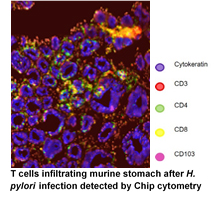The roles of tissue resident T cells during H. pylori infection and after immunization
Helicobacter pylori infection is one of the most common bacterial infection worldwide. Gastric colonization with H. pylori can lead to various upper gastrointestinal disorders, such as gastritis, peptic ulcer disease, gastric mucosa-associated lymphoid tissue (MALT) lymphoma, and gastric cancer. Different immune cell subsets can be found in the stomach of infected subjects. In particular, T cells have been shown to infiltrate and highly contribute to gastric inflammation in order to control the infection. Tissue-resident memory T cells (TRM) have been recently described as important players in the immune response against different infections. They reside in the non-lymphoid tissues without entering recirculation, and after most infections they emerge after the resolution of local inflammation. Therefore, they can rapidly react to local infection by forming secondary TRM cells from pre-existing TRM cells or from their precursors recruited from the circulation. Effector T cells within non-inflamed tissues can also differentiate into TRM cells after adaption to local chemokines. TRM cells are present during H. pylori infection. However, their putative functions have not been clearly defined. Moreover, the contribution of H. pylori virulence factors to the induction of TRM cells remains unclear. Therefore, we explore the function of stomach TRM cells after H. pylori infection, and the contribution of different H. pylori virulence factors to the induction of TRM cell responses. Further, we want to analyse the relevance of TRM cells for protection upon prophylactic immunization (see ● Vaccine development against H. pylori).



